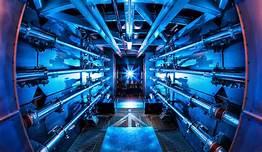Building high energy and high repetition lasers using current state of the art technologies have limitations. They would require large aperture gain medium and optics, which are challenging to manufacture and limit the type of gain medium. With large components, there is limited transverse gain control and low efficiency. Additionally, as with any laser, some of the pump energy is converted to waste heat rather than laser power. The residual heat in an Inertial Fusion Energy (IFE)-class or other high rep-rate/average power laser will significantly deteriorate performance by inducing thermal lensing and stress that eventually causes failure.
There is a need for innovative approaches to overcome these disadvantages with particular focus on effective heat extraction from laser gain medium at high power operations (>kJ, up to and beyond 10 Hz rep rate) and controlling parasitic lasing - losses due to traverse amplified spontaneous emission (TASE) of the amplifier, which reduces stored energy after pumping.
LLNL researchers developed a driver design for IFE-class lasers that allow for simultaneous high energy and high repetition rate operations. The LLNL invention integrates an amplifier head featuring a mosaic architecture with a modified high power diode delivery system that is designed to achieve uniform and geometry-match illumination of the mosaic structured amplifier module.
- No large optical components and gain media needed for high energy, high repetition laser systems. The required optics for this LLNL invention can remain small, so there is no issues with manufacturability of crystalline, ceramic and/or glass parts. Small components also enable access to more efficient gain media that are not available for large apertures.
- Potential increase of doping concentration in the gain media so that they can be thinner while still maintaining high performance.
- Limited size of gain medium since amplifier module is divided up into discrete sub-apertures, which also limits the TG (transverse gain) and allows for efficient extraction of the stored energy in the longitudinal direction.
- Effective cooling due to mosaic configuration.
- A modified diode delivery system capable of spatially homogenous pumping a full mosaic structure.
IFE, scientific research, national security, laser material processing, medical
Current stage of technology development:
TRL ☒ 0-2 ☐ 3-5 ☐ 5-9
LLNL has filed for patent protection on this invention.


